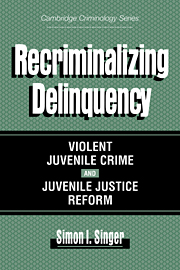Book contents
- Frontmatter
- Contents
- List of Figures and Tables
- Acknowledgments
- Introduction
- 1 Recriminalizing Violent Juvenile Crime
- 2 Taking Stock of Juvenile Justice Reforms
- 3 Recriminalization on the Move and Its Legal Rules
- 4 Contextual and Legal Reasons for Identifying Juveniles as Criminal Offenders
- 5 The Case Processing of Juvenile Offenders: From Arrest to Disposition
- 6 Recriminalization and Organizing for Deterrence
- 7 Convicted Juvenile Offenders in a Maximum Security Institution
- 8 Concluding “Real” Reasons for Recriminalizing Delinquency
- Appendixes
- Notes
- References
- Index
7 - Convicted Juvenile Offenders in a Maximum Security Institution
Published online by Cambridge University Press: 29 September 2009
- Frontmatter
- Contents
- List of Figures and Tables
- Acknowledgments
- Introduction
- 1 Recriminalizing Violent Juvenile Crime
- 2 Taking Stock of Juvenile Justice Reforms
- 3 Recriminalization on the Move and Its Legal Rules
- 4 Contextual and Legal Reasons for Identifying Juveniles as Criminal Offenders
- 5 The Case Processing of Juvenile Offenders: From Arrest to Disposition
- 6 Recriminalization and Organizing for Deterrence
- 7 Convicted Juvenile Offenders in a Maximum Security Institution
- 8 Concluding “Real” Reasons for Recriminalizing Delinquency
- Appendixes
- Notes
- References
- Index
Summary
although it is difficult to see the impact of the JO law on rates of crime, the effect of recriminalization is most visible at the hard end of the system. Among the nearly 17,000 juveniles arrested as juvenile offenders in New York State between 1979 and 1990, about 11 percent were incarcerated. Among those incarcerated, a proportion of convicted juvenile offenders received sentences that were substantially longer than what they could have received in juvenile court. And recall that since passage of the JO law, the population of juveniles incarcerated in New York's maximum security institutions increased substantially (see Table 5.16 in Chapter 5).
This chapter is about one of the secure Division for Youth (DFY) facilities that was created as a consequence of the JO law. The JO law requires that sentenced juvenile offenders initially be incarcerated in maximum security prisons operated by DFY. Those secure facilities are to provide “educational” and “rehabilitative” services as part of their treatment-oriented mandate. In a sense, the transfer of juveniles to the criminal justice system ends at the point of incarceration, when juveniles are returned to the juvenile justice system's divisions for youths and maximum security institutions. But it is a momentary return; after serving the minimum period of incarceration, juvenile offenders are subject to adult parole and to possible transfer to an adult prison system. For juvenile offenders sentenced to a maximum of life in prison for murder, a division for youth secure facility is only a temporary residential setting.
- Type
- Chapter
- Information
- Recriminalizing DelinquencyViolent Juvenile Crime and Juvenile Justice Reform, pp. 165 - 186Publisher: Cambridge University PressPrint publication year: 1996



